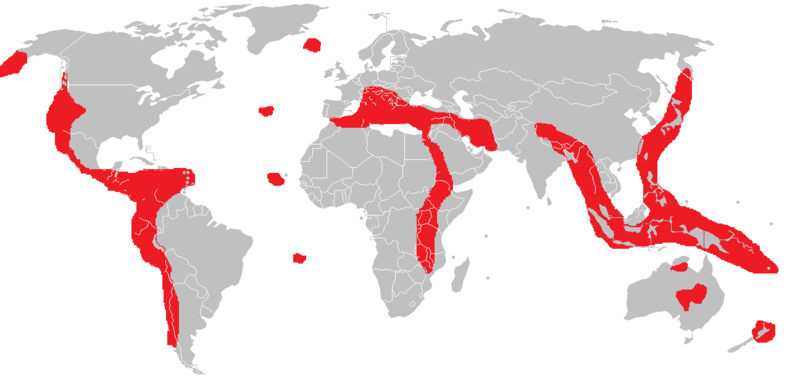Geothermal district heating

Not to be confused with geothermal heat pumps, which use energy stored under the Earth's surface that originated from the Sun.
Geothermal district heating is the use of the Earth's natural thermal energy in order to provide heat to a group of buildings.[2](see Figure 1). There are locations on Earth that may make better use of this, due to being situated on "geothermal hot spots" (shown in Figure 2) where they have access to higher underground temperatures. The first use of district heating occurred in the 14th century in France.[3]
Temperatures above 40°C and less than 150°C are ideal for these applications, since geothermal temperatures above 150°C are better used for geothermal electricity generation.[4] Between 90°C and 150°C is considered a "moderate" temperature range,[5] and can be used in certain low-temperature power plants, or in more energy-intensive industrial heating applications.[6]

Use
The primary uses of geothermal heat is for residential or commercial water heating and space heating. Hot water from surface features or shallow wells circulates through individual buildings or community-wide water systems. Excess heat from these applications may also be sent to sidewalk heaters in order to melt snow (Figure 1).[5]
Some countries that are located on geothermal hot spots rely on these methods of heating. In Iceland, nine out of ten buildings are heated using geothermal energy.[8] Certain places within the USA and Turkey also make considerable use of geothermal district heating.[9][10] The United States' installed capacity of direct use systems totals 470 MW, or enough to heat 40 000 average-sized houses.[4]
For Further Reading
- Geothermal energy
- Geothermal industrial heat
- Geothermal electricity
- Geothermal gradient
- Or explore a random page
References
- ↑ Wikimedia Commons [Online], Available: https://commons.wikimedia.org/wiki/File:%22Under-floor_heating%22_in_the_street.jpg
- ↑ GEODH. (August 13, 2015). Developing Geothermal District Heating In Europe [Online], Available: http://geodh.eu/wp-content/uploads/2012/07/GeoDH-Report-2014_web.pdf
- ↑ J.P Gilbert and F. Jaudin, Using Geothermal Waters in France: The District Heating System of Chaudes-Aigues from the Middle Ages [PDF], Available: http://pubs.geothermal-library.org/lib/grc/1018282.pdf
- ↑ 4.0 4.1 Oregon Tech. (August 13, 2015). Geo-Heat Center [Online], Available: http://www.oit.edu/orec/geo-heat-center
- ↑ 5.0 5.1 R. Wolfson, "Energy from Earth and Moon" in Energy, Environment, and Climate, 2nd ed., New York, NY: W.W. Norton & Company, 2012, ch. 8, pp. 204-224
- ↑ Geothermal Education Office 2005. Geothermal Energy Uses [Graphic]
- ↑ Adapted from: R. Wolfson, "Energy from Earth and Moon" in Energy, Environment, and Climate, 2nd ed., New York, NY: W.W. Norton & Company, 2012, ch. 8, pp. 204-224
- ↑ National Energy Authority. (August 13, 2015). Direct Use of Geothermal Resources [Online], Available: http://www.nea.is/geothermal/direct-utilization/
- ↑ Boise Idaho. (August 13, 2015). Geothermal Heating District [Online], Available: http://publicworks.cityofboise.org/services/geothermal/
- ↑ Science Direct. (August 13, 2015) Geothermal district heating applications in Turkey: a case study of Izmir–Balcova [Online], Available: http://www.sciencedirect.com/science/article/pii/S0196890402001218

